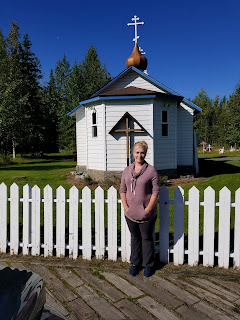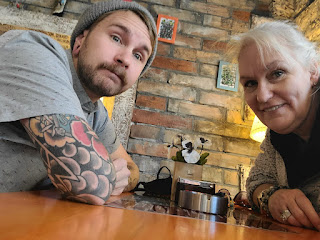Oregon Irish Famine Memorial Cross
Richard and I recently took a trip to Portland Oregon, we
happened to be driving to an afternoon hike we had planned when I saw the
incredible stone Celtic Cross rising out of the hillside, I was literally
speechless simply saying oh oh oh over and over. As we drove closer, I realized that the cross
was located at a cemetery; I believe at that point I found my voice to say, “It’s
an old cemetery” to which my darling husband replied, “I know where we will be
spending tomorrow afternoon”. I am
blessed to have a husband who encourages me to embrace my love of old
cemeteries.
***This post started out about our afternoon at that
cemetery, but I quickly realized that the Irish immigrants buried at the memorial
sight wanted to be recognized, so the post took on new life, a later post will
cover the rest of the beautiful cemetery****
The Cemetery
The next day as promised we loaded up the rental car, made a
coffee stop and headed back to wander around Mount Calvary Catholic Cemetery. It turns out the incredible cross I had seen
is a memorial erected in honor of the more than a million Irish people who
starved and over a million more that fled, primarily to the United States
during An Gorta Mor, the great hunger. Ireland’s potato famine which lasted from 1845 to
1851. In 1845 an airborne fungus phytopthora
infestans made its way to Ireland by way of cargo ships
arriving from the Americas, the fungus turned the once lush green potato fields
to black mush, destroying the food the rural Irish pheasants depended on for
their very survival.
The Potato Famine
The potato famine began in Ireland in September 1845, the
leaves on the potato plants began to turn black and rot. Winds carried the
fungus infecting the plants all along the countryside of Dublin spreading the
spores to healthy plants. The plants fermented
which in turn provided nourishment for the fungus to thrive; potatoes dug out
of the ground were rotten. The Irish
peasants relied on potatoes for their survival, without their food staple these
people could not survive. Over the next
few years an estimated 1 million people had died from starvation and disease.
The death toll was so great and those surviving had little strength left
themselves so often important burial practices had to be suspended, normal
wakes and religious ceremonies had to be put aside. Many of the dead were simply covered
in a shroud and buried in mass graves. Some families were able to “borrow” a “ trap” coffin for a small ceremony, this was
a coffin with a trap door at the bottom, the body was wrapped inside and the
coffin placed over the grave, a lever was then pulled and the bottom opened up
dropping the body into the grave, the coffin could then be used again and
again.
Irish Immigrants to
America
Many Irish left Ireland coming to the United States in
search of a better life during this time. Prior to 1846 the majority of Irish
who had immigrated to America were Protestant or Presbyterian many whose first
language was English, they came with skills and small amount of money saved to
help them as they began their new life.
The Irish immigrants during An Gorta Mor were predominantly Catholic who
spoke mainly Irish, and little if any English, they gathered every cent they could to pay for passage and arrived
with minimal skills and no money. These desperate people boarded “coffin ships”
a ship in such poor conditions many were barely seaworthy. The ships were
overcrowded and disease ridden with minimal access to food and clean water and
only inches allotted to each person as sleeping space. Thousands would die at
sea during the voyage; those that arrived had to take whatever jobs they could find,
usually low paying unskilled jobs. These
immigrants were often met by signs saying “ No Irish Need Apply”. Life for many was barely better than what they
had left behind. However, these were
strong willed people who had already endured centuries of oppression in their homeland;
they came together and built new communities.
Irish Immigrants in Oregon
While most immegrants who made the trip to the United Stated settled in bigger cities such as New York or Boston Some of the immigrants came directly to Oregon from
Ireland and others were able to work and save enough to make the trip west
across the Oregon Trail. Having spent
time in both Ireland and Portland, it is easy to see how the Irish immigrants
would have felt at home in the Portland area. In 1850 when the first census was
taken in Portland Oregon, there were only 12 Irish born listed out of a
population of 821, 10 years later in 1860 10% of the city’s population was
Irish born and that number continued to grow over the next several years.
Today the majority of Irish Catholic men, women, and children who have died
in Portland are buried at the Mount Calvary Cemetery. Immigrants who came to
Oregon to escape the famine along with their dependents are buried in this
cemetery so it is fitting that when a memorial was proposed to honor those who
lost their lives and those who fled it was decided that it would stand in this
beautiful cemetery.
Oregon Irish Famine Memorial Cross
Irish sculptor Brendan McGloin spent 2 ½ years carving this 14-foot
tall Celtic cross modeled after the iconic High Cross "sermon in
stone" which was erected at
Clonmacnois, Co Offaly, around 912 AD for High King Flann The new cross was then transported from Donegal to Portland where it was unveiled on 13
December 2008. Irelands President Mary McAlesse unveiled the cross having made
the trip from Ireland to Portland for the ceremony.
The foundation of the
cross holds a stone from the Hill of Tara, seat of the historic High Kings of
Ireland, to commemorate the past; a euro for the present; and a stone from
County Mayo on April 10, the day the Good Friday Peace Agreement was signed in
1998, represents Ireland's future.
Originally the memorial was to placed downtown, but it is
said the ghosts of Mt. Calvary would not have it. In an interview David O’Longaigh
the Portland engineer who instigated the original project along with the
Ancient order of Hibernians said “ The Famine Irish are all buried here, we did
not find Mt. Calvary, the Irish resting here found us”.
As I stood next to this incredible memorial reading the names I could I could almost hear the voices of the people being remembered here.If you find yourself in Portland take a drive over and visit the memorial and if you listen closely you might hear a little Irish tune being sung on the Breeze.





Comments
Post a Comment